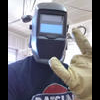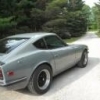What the condenser does is provide a TEMPORARY low impedance path for the primary current until the points gap is large enough that the "kick back" from the primary is not enough to arc across the gap. That's the nutshell. Here's some detail. Start with some arc theory: 1) It's easier to establish an arc across a smaller gap than a large one.2) It's easier to MAINTAIN an arc than to establish one in the first place. So if you can prevent an arc from forming when the points are first opening and the gap is very small, you might be able to prevent an arc from ever forming at all because the points gap gets wider as the cam rotates and opens it further. in other words, if you can delay the voltage presented across the points gap until the gap is wide enough to withstand that voltage, then you will not get an arc at all. The condenser provides that delay with it's temporary path. The condenser has to be large enough to suppress the gap voltage until the points are wide enough to resist the arc, but as small as possible since any energy that you use to fill the condenser doesn't go into making a spark at the spark plug. The bottom line is you should use the smallest value you can get away with before you start arcing your points. But here's the tricky part... Remember the part about it being easier to maintain an arc than to establish one? That's where the ignition spark performance stuff comes in. You might think to yourself "Heck, I want the hottest spark possible at my plugs and I don't care if I have to replace my points more often to get it. I'm not going to use any condenser at all and that way, I'll get more energy at my plugs." Well, not true... If you don't use any condenser at all and simply let the arc form across the points gap, you're bleeding energy out of your ignition coil through that arc the whole time that arc exists. So by the time the primary energy is no longer high enough to maintain the arc, you've lost a bunch of energy that COULD have been put into a secondary side spark but is no longer available because it went through the points arc instead. So if you can time it correctly such that the condenser is full at the exact same time when the primary side voltage is not high enough to jump the points gap, then you will get a faster change in the primary current and hence a hotter spark on the secondary side. In other words, the resistance to flow through an already established arc is lower than the resistance to flow though a full condenser. Use the smallest condenser you can without arcing the points. Not only will you not burn up your points, but you'll also get the most rapid change in primary current which creates the hottest spark at the secondary. Quiz on Monday.











